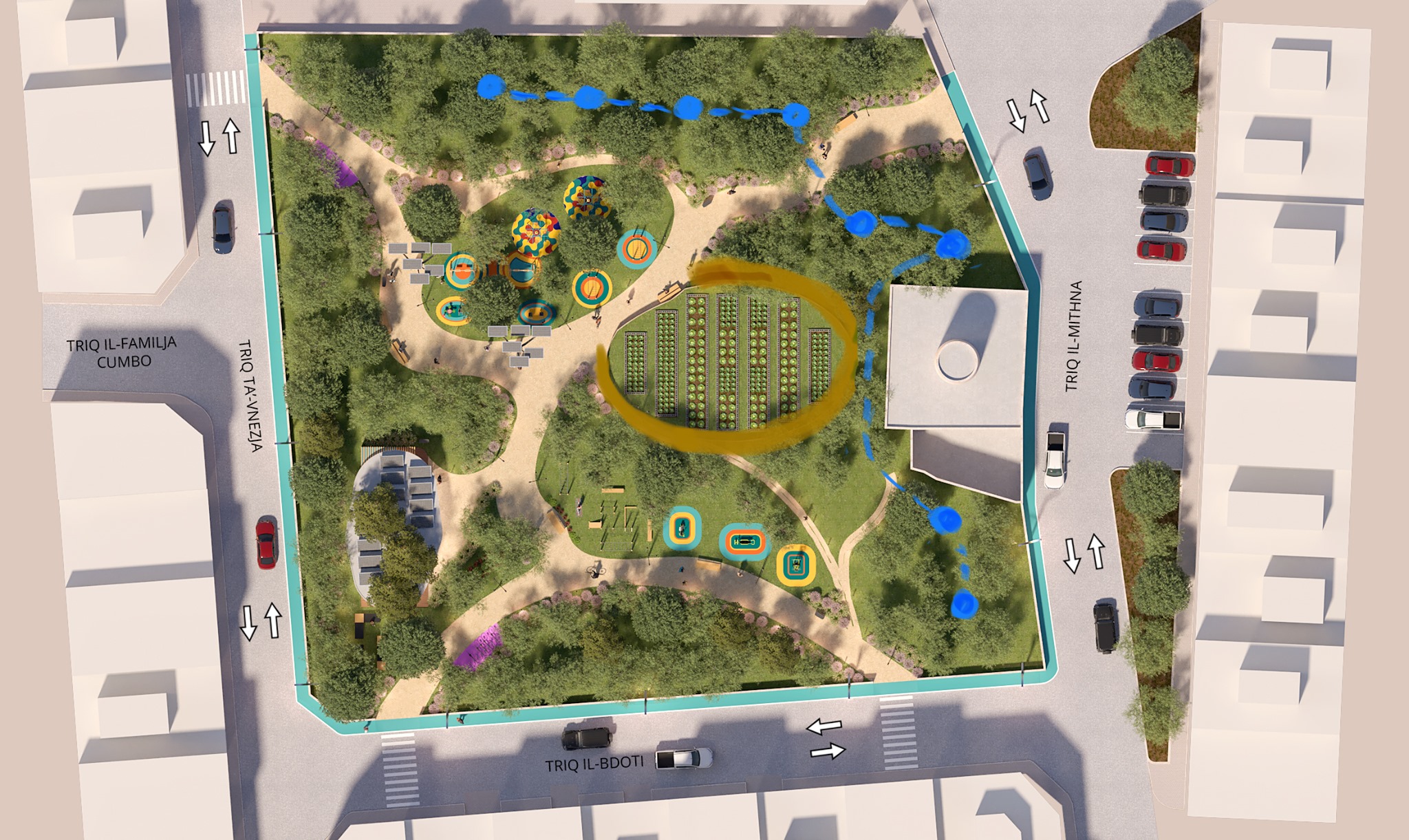Criticism for the planned renovation of the field known as ‘Ta’ Ċikku Fenech’ in Mosta has been fast and furious, with many lamenting the winning design’s manicured approach to green open space.
However, in comments made to WhosWho.mt, competing architectural design firm Nidum, whose losing proposal has been met with warm praise online, made it clear that the contest was professionally run with clear criteria for the adjudication of submissions.
On Wednesday, the Parliamentary Secretary for Citizenship and Communities Alex Muscat, responsible for disbursements from the National Development and Social Fund (NDSF), announced that the 4,000 sqm field, which has lain abandoned since Mr Fenech passed away seven years ago, would be benefitting from a €1 million investment to landscape it, add facilities for visitors, and thereby return the land to public use.

The winning design for the creation of a public garden on the site known as the field 'Ta' Ċikku Fenech'
The field was allegedly part of the Church-State agreement, with the condition that it is given up for public use.
The NDSF receives revenues generated from the cash-for-passports scheme, and has since been used to support communal projects in Malta and Gozo.
Parliamentary Secretary Muscat said that the land would become an accessible garden, with the approximately 90 indigenous trees located on it being protected. He noted that the pathways would be made of soil and gravel, while Mr Fenech’s iconic Land Rover, from which he used to sell vegetables, would be incorporated in the project.
The announcement was met with overwhelmingly negative reviews on national and Mosta-based social media groups, with many decrying the ‘artificial landscaping’ of the winning design, although many also welcomed the investment into green open spaces in a heavily urbanised area.
Architectural design firm Nidum released its own submission, prepared in collaboration with Halmann Vella, to the competition organised by WasteServ Ltd under the GreenServ brand.
Taking to Facebook, Nidum said, “Our submission for the Urban Greening Pilot Project Competition adopts principles of responsible and ethical urban design, where active natural elements are used to drive transformation over time.”
“The contest was an opportunity to demonstrate that the main purpose of urban planning can be redirected away from the creation of solid forms to prioritising 'empty' ones; left over spaces, ‘voids’, no longer to be treated as anonymous infills between built structures, but as a central theme of contemporary urban design, that of creating usable ‘natural’ spaces to improve community well-being.
"A new paradigm, where gardens and green environments are simultaneously enjoyable, but also able to safeguard and promote the biodiversity of nature within our towns.
“Our scope was twofold: to minimise any impact on the existing grove, and instead enhance the sites’ biodiversity using local flora and fauna, while making small pockets below the olives more accessible. The grove, remaining untouched, becomes the heart of a new public space that instead extends across the road to create a wider public realm.
“The new garden, an outdoor museum of botanical sciences, an incubator of local biodiversity, and a repository of knowledge, is encircled by a continuum of public space that prioritises pedestrians, cyclists and public transport users without disturbing essential traffic flows, to guarantee slow, leisurely mobility on a neighbourhood scale.”
WhosWho.mt reached out to Nidum to better understand their intentions behind the design.
Co-founder Alberto Miceli-Farrugia said the design was the fruit of a collaboration with stone-working company Halmann Vella, who supported the design team with their technical knowledge in works of a similar nature, with their project management capabilities, and through their interest in developing workable technical and commercial solutions for recycled materials such as reconstituted stone.
He also credited the expertise of the reputable consultants for the proposal, Prof. Arch Elisa Cattaneo and Arch. Davide Bardini, saying that their “approach to designing with landscape is fascinating. It allowed us to focus on the existing natural ecology of the site, giving nature a free hand to help repair or mitigate some of the impact we have on our world.”
Mr Miceli-Farrugia stated that it immediately became apparent that no more than the gentlest of touches was required, to “respect the extraordinary rawness and beauty of the untamed and unmaintained olive grove lying unexpectedly in the heart of the town”.
He continued: “We therefore sought to provide this ecology the assistance necessary to allow it to flourish. It would become a natural environment the community could access and enjoy for leisure and more.
“Almost a spiritual space to re-experience the natural environment that pre-dated the urban sprawl, where our children can connect with nature as they play.”
He admits that the approach resulted in some “risky decisions”, suggesting for example that areas of the garden would ideally not be accessible, in order to encourage a more uncontrolled biodiversity, and to promote the return to the garden of fauna like bees and butterflies, as well as flora.”
He says the firm’s goal was to make this a prototype project, to envisage how architects can work with the natural landscape to embellish Malta’s towns and villages to help improve residents’ mental and physical well-being.
Mr Miceli-Farrugia describes the intention as a way to see “man in harmony with nature, and not in opposition to it.”
While noting that the proposal was “regrettably” not selected, he defends the competition’s organisation, saying the contest was “professionally run”.
“There were clear criteria for the adjudication of the submissions, and these were communicated to us. One proposal had to be selected, and the jury had a difficult decision to make.”
Asked for suggestions for future competitions, he says “it would be ideal” if the contracting side of a project is separated from the selection of a design.
“Our communities deserve, and they increasingly expect, the best designs possible, and architecture design contests which are not over dependent on costs, are one of the best ways of providing for this.”
